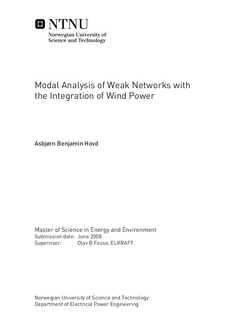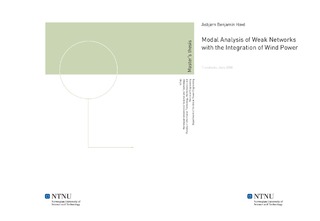| dc.contributor.advisor | Fosso, Olav B | nb_NO |
| dc.contributor.author | Hovd, Asbjørn Benjamin | nb_NO |
| dc.date.accessioned | 2014-12-19T13:50:56Z | |
| dc.date.available | 2014-12-19T13:50:56Z | |
| dc.date.created | 2010-09-03 | nb_NO |
| dc.date.issued | 2008 | nb_NO |
| dc.identifier | 347648 | nb_NO |
| dc.identifier | ntnudaim:4096 | nb_NO |
| dc.identifier.uri | http://hdl.handle.net/11250/256491 | |
| dc.description.abstract | In this master thesis the theory and practical use of modal analysis is explained, giving an introduction to the possibilities of modal analysis. The master thesis starts with a look at wind power and the design of a modern wind turbine. Two models, one for constant wind speed wind turbines and one for variable speed wind turbines, are presented. An example shows how modal analysis can be utilized to evaluate a network's dynamic stability. Simulations are performed on a two-area network where different wind power models are tested and compared. A two-mass model is used to model a constant wind turbine. The model consists of an asynchronous generator, a turbine, and a low speed shaft with a tensional stiffness. The model representing the variable speed wind turbine is based on a DFIG model included in the simulation software. The two-area network consists of two areas connected together through a long line between Bus 5 and Bus 6. Area 1 has two production sources, one placed in Bus 1 and one placed in Bus 2. The second area represents a large network modelled as a very large synchronous generator with a high inertia. The calculations have showed how modal analysis can be used to evaluate a system by using linearized differential equations and how the systems robustness against small disturbances can be altered by changing the systems parameters. Simulations have verified that a two-mass model must be used when modelling a constant speed wind turbine. The inertia of the turbine will greatly influence the model's behaviour and must therefore be included in the model. Eigenvalues analysis performed during different wind speeds have documented that wind power will not become less stable towards small disturbances when operated at low wind speed conditions. | nb_NO |
| dc.language | eng | nb_NO |
| dc.publisher | Institutt for elkraftteknikk | nb_NO |
| dc.subject | ntnudaim | no_NO |
| dc.subject | MSELPOWER Master of Science in Electric Power Engineering | no_NO |
| dc.subject | Elektrisk Energiteknikk | no_NO |
| dc.title | Modal Analysis of Weak Networks with the Integration of Wind Power | nb_NO |
| dc.type | Master thesis | nb_NO |
| dc.source.pagenumber | 112 | nb_NO |
| dc.contributor.department | Norges teknisk-naturvitenskapelige universitet, Fakultet for informasjonsteknologi, matematikk og elektroteknikk, Institutt for elkraftteknikk | nb_NO |

